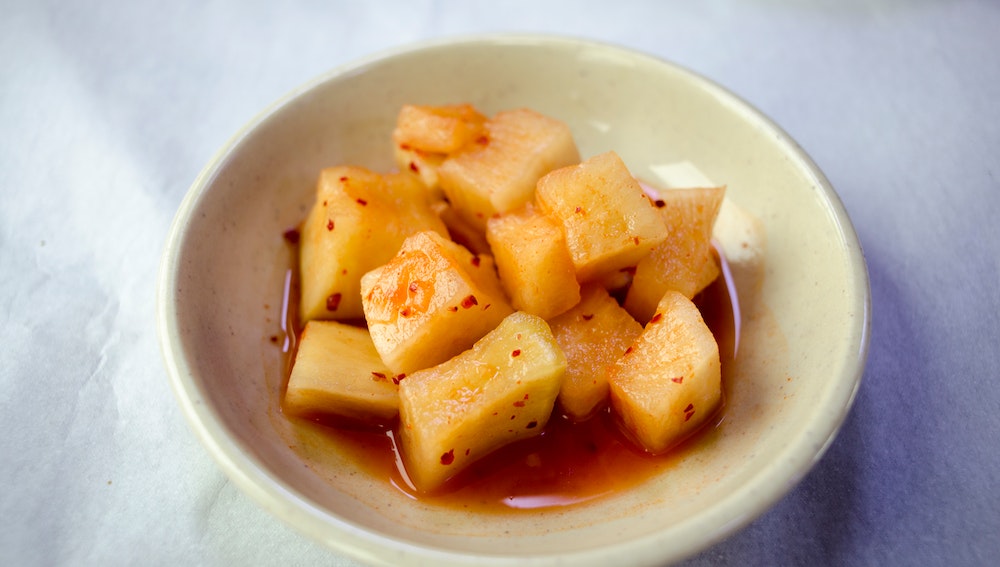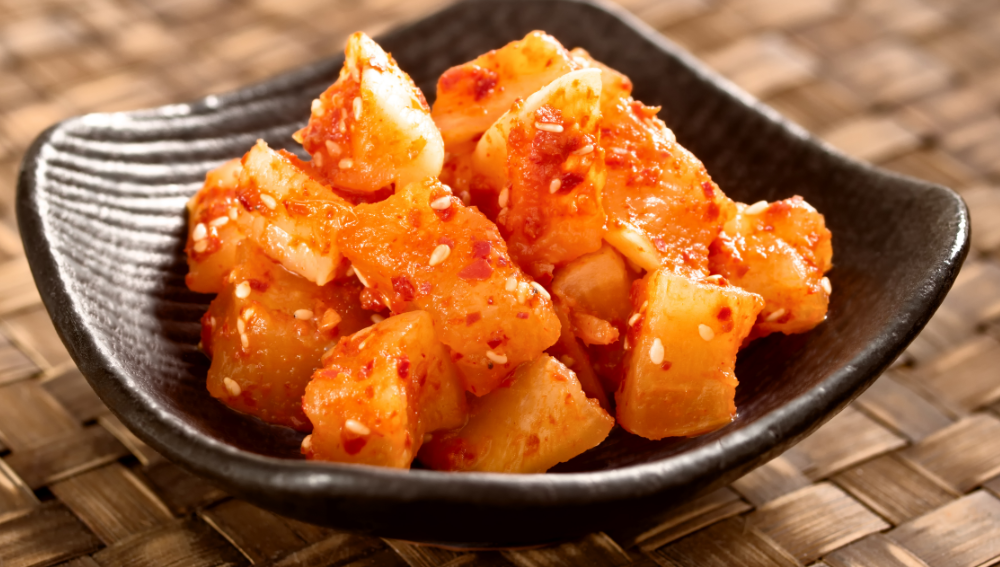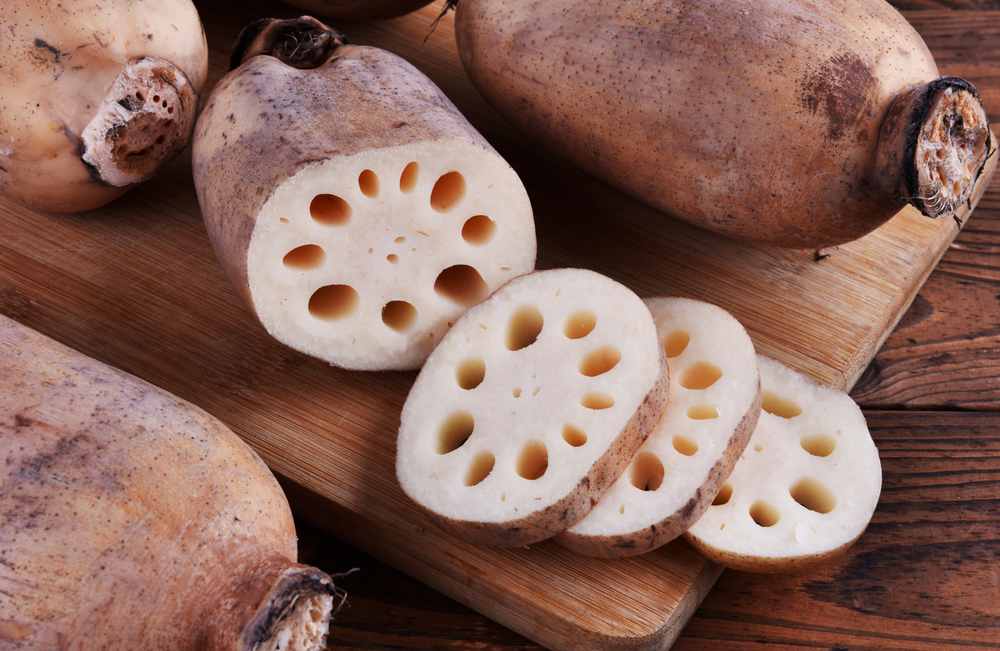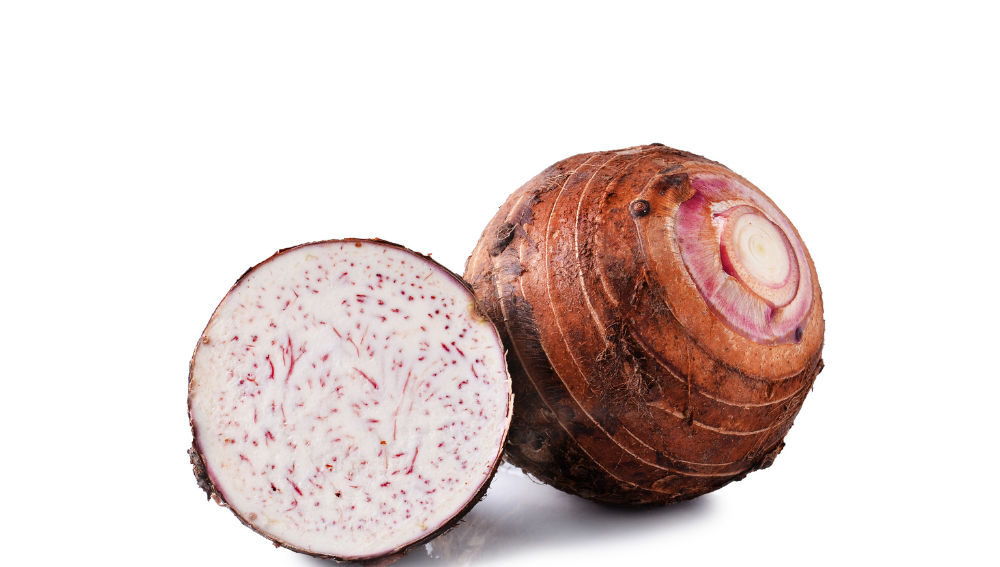Korean radish, also known as mu or moo, is a staple ingredient in many traditional Korean dishes. It is a versatile root vegetable that can be used in a variety of dishes, ranging from salads to stews.
However, there may be instances when this key ingredient is not available or you are looking for an alternative to match your taste preferences.
In such cases, finding a suitable Korean radish substitute without compromising the taste and authenticity of the dish is essential. This article will delve into some of the best Korean radish substitutes that can deliver a similar taste, texture, and culinary experience.
The substitutes mentioned in this article are not only easy to find but are also perfect for incorporating into classic Korean dishes.
Key Takeaways
- Discover top Korean radish substitutes in various dishes
- Learn how to prepare and incorporate alternatives without sacrificing taste
- Gain insights into the health benefits of Korean radish and its substitutes
Understanding Korean Radish

Korean radish, also known as mu or moo, is a root vegetable that is a staple ingredient in Korean cuisine. It is a versatile vegetable with a crisp texture and mild flavor, making it suitable for various dishes such as kimchi, soups, and stews.
Korean radishes are typically larger and rounder than other radish varieties with a greenish-white hue. The texture of the radish is firm, making it an ideal choice for pickling and fermenting.
In addition to its culinary uses, Korean radish is known for its health benefits, as it is rich in vitamins and minerals.
South Korean immigrants have played a significant role in popularizing Korean radish in different parts of the world. The unique flavor and texture of this vegetable have led to its increased demand in countries where Korean cuisine is gaining popularity.
As a result, Korean radish is now available in various grocery stores and specialized Asian markets outside Korea.
In conclusion, Korean radish is an essential ingredient in many Korean dishes, thanks to its versatility, taste, and nutritional value. Its popularity has grown beyond Korea’s borders, with South Korean immigrants contributing to the global awareness and appreciation for this unique root vegetable.
Best Substitutes for Korean Radish
White Radish Alternatives
White radish, also known as European radish, is a good substitute for Korean radish in many dishes. It has a similar taste, texture, and appearance, making it an easy swap without altering the overall flavor of the dish.
However, the spiciness of white radish may be less intense compared to Korean radish.
To use white radish as a substitute, replace Korean radish with an equal amount of chopped white radish in recipes like kimchi, pickles, or stews.
Daikon as a Substitute
Daikon, a Japanese radish, is another suitable alternative to Korean radish. With its mild flavor and crunchy texture, daikon can easily be incorporated into various recipes.
Although slightly sweeter and less peppery than its Korean counterpart, daikon still provides a satisfying crunch and taste profile.
For substituting daikon, follow a 1:1 ratio, meaning that one cup of chopped daikon can replace one cup of Korean radish in dishes such as salads, soups, or stir-fries.
Carrot and White Radish Mix
A mix of carrot and white radish can also serve as a replacement for Korean radish. The combination of these two ingredients helps to achieve both the slightly sweet yet peppery flavor found in Korean radish.
Additionally, using carrots enhances the color and visual appeal of the dish.
To create this substitute, mix equal parts of chopped carrot and white radish to use in place of Korean radish. This blend can be used in various dishes like wraps, slaws, or fermented preparations.
Preparation Method

Peeling and Cutting
When preparing Korean radish or its substitute, start by peeling the skin off with a vegetable peeler. Once peeled, proceed to cut the radish into bite-sized cubes or thin slices, depending on the dish you are making.
Make sure to wash the radish thoroughly before cutting to remove any dirt or residue.
Boiling Process
To soften the radish and enhance its flavor, boil the cut pieces in a pot of water. Add enough water to cover the radish and let it simmer for about 15-20 minutes, or until they become tender.
Check for doneness by piercing a piece with a fork; it should easily slide in. Once the radish has reached the desired texture, drain the water and set it aside for cooling.
Seasoning and Flavoring
The key to making delicious Korean radish dishes lies in the seasoning and flavoring. A basic seasoning mixture can be created by combining:
- Salt (1 teaspoon)
- Sugar (1 tablespoon)
- Minced garlic (1 tablespoon)
- Green onions (2 tablespoons, chopped)
- Red pepper flakes (1 tablespoon)
Mix these ingredients well and then combine them with your boiled radish. Gently toss the radish in the seasoning to evenly coat the pieces.
Feel free to adjust the salt and sugar quantities according to your taste preferences. Let the radish marinate for at least 10 minutes to allow the flavors to meld, and then your Korean radish or its substitute is ready to be served in various dishes.
Incorporation in Korean Dishes

Korean radish is a versatile ingredient used in a variety of Korean dishes. One of its most popular uses is in kimchi, where it adds a crunchy texture and slightly sweet flavor.
When a substitute is needed, daikon radish is an ideal option due to its similar taste and texture.
In jajangmyeon, a popular Korean-Chinese noodle dish, vegetables such as radish play an essential role. Korean radish can be replaced by daikon or even turnips without compromising the dish’s taste.
For an easy preparation, use a food processor to grate or chop the alternatives.
Doenjang jjigae, a delicious soybean-paste stew, often incorporates Korean radish to enhance flavors and contribute to the dish’s nutritional value. When replacing Korean radish in doenjang jjigae, consider alternatives like daikon, turnips, or rutabaga.
These options will provide similar flavors and textures while maintaining the dish’s authenticity.
Another iconic dish, ganjang gejang, features soy-marinated raw crabs alongside various vegetables, including Korean radish. In this case, opting for daikon as a substitute maintains the dish’s integrity.
Radish substitutes can also be applied to popular dishes like kimbap, a Korean sushi roll. The crisp texture of Korean radish adds depth to the roll’s interior.
Both daikon radish and turnips can be an ideal alternative without compromising the overall taste.
In maeuntang, a spicy fish soup, the addition of radish enhances flavors and adds thickness to the broth. Here, daikon radish or turnips can be used as practical alternatives.
Finally, in bulgogi, the marinated meat dish, slices of Korean radish are often served along with the meat. When Korean radish is unavailable, daikon slices can be used without affecting the dish’s overall quality.
In conclusion, while Korean radish is a staple in many Korean dishes, there are suitable alternatives such as daikon radish, turnips, and rutabaga that can be effectively incorporated into the dishes without compromising taste or authenticity.
Health Benefits of Korean Radish and Its Substitutes
Korean radish, known for its crisp texture and slightly sweet taste, offers numerous health benefits. It is low in calories, making it an ideal addition to meals for those looking to maintain or lose weight.
The high water content keeps the body hydrated, while its fiber content promotes better digestion and prevents constipation.
The Korean radish contains essential nutrients, such as vitamin C, which boosts the immune system, and potassium, which maintains healthy blood pressure.
Additionally, compounds called glucosinolates present in this vegetable provide a natural detoxification effect, aiding in the removal of harmful substances from the body.
Some substitutes for Korean radish offer similar health benefits. Among these substitutes are:
- Daikon radish: Similar in appearance and taste to Korean radish, daikon radish is rich in vitamins A, C, and K. It also contains beneficial enzymes that aid in digestion and the absorption of nutrients.
- Turnips: Turnips provide a slightly more bitter taste but have comparable nutritional value, containing high levels of B vitamins, vitamin C, and fiber. They also boast a low glycemic index, making them suitable for those looking to regulate blood sugar levels.
- Rutabaga: This root vegetable is slightly sweeter than Korean radish but still offers various health benefits. Rutabaga has a high fiber content, helping regulate digestion and contributing to overall gut health.
When used as a radish substitute in dishes, it is essential to consider the other ingredients for optimal health benefits. For instance, using ginger in recipes can enhance flavor and offer its anti-inflammatory and antioxidant properties.
Garlic is known for its ability to boost the immune system and lower blood pressure.
Remember to be mindful of the amount of salt and pepper used while seasoning these vegetables, as excessive salt intake can cause higher blood pressure.
Balancing flavors with different vegetables and high-quality lean meats can lead to a delicious and nourishing dish with a wide array of health advantages.
Influence of Korean Cuisine in American Kitchens

Over the years, Korean cuisine has significantly impacted American kitchens, especially in metropolitan areas such as the Atlanta and New York City. The growing population of Korean Americans has led to an increased demand for staple ingredients and authentic dishes.
As a result, more supermarkets and specialty stores carry Korean products, making it easier for people to prepare Korean dishes at home.
One factor contributing to the popularity of Korean cuisine in America is the Korean language schools, where students not only learn the language but also get exposed to the rich culture of Korea.
Many participants become attracted to the food and adopt Korean recipes as part of their culinary identity.
Korean American chefs have also played a key role in introducing Korean flavors to mainstream American audiences. By merging traditional preparations with modern techniques, these chefs present an exciting fusion of Korean and American dishes.
This innovative blend has inspired home cooks to experiment with Korean ingredients, leading to a more prominent presence of Korean dishes in American kitchens.
Moreover, the array of health benefits associated with traditional Korean meals has drawn Americans to incorporate these dishes into their diet. Kimchi, a fermented vegetable mixture and a signature Korean dish, is well-known for its probiotic properties.
Other dishes, like bibimbap and bulgogi, are packed with nutritious vegetables and lean proteins that also appeal to health-conscious individuals.
In conclusion, the influence of Korean cuisine in American kitchens is evident in the growing popularity of Korean dishes and the availability of Korean ingredients in stores.
Both Korean American chefs and the increasing interest in Korean language and culture have contributed to this trend, allowing more people to enjoy the unique flavors, textures, and health benefits of Korean cooking.
Conclusion
In summary, finding a suitable Korean radish substitute is achievable with various options available. Daikon radish stands out as the most popular and fitting substitute due to its size, taste, and texture similarities.
Other alternatives include turnips, jicama, and watermelon radish, depending on the desired flavor and usage in a recipe.
It is essential for individuals to assess each substitute’s characteristics, considering factors such as taste, texture, and appearance to find the best substitution for their specific dish. Here are the key points mentioned:
- Daikon radish: Similar in size, taste, and texture; best all-around substitute
- Turnips: Slightly stronger flavor and firmer texture; suitable for soups and stews
- Jicama: Crunchy texture and mild taste; ideal for salads and pickling
- Watermelon radish: Visually striking, mild flavor; perfect for garnishing and salads
By being aware of these alternative options, avid cooks and food enthusiasts can confidently adapt their recipes without compromising the integrity of the dish.
Remember to choose wisely, and always consider the specific requirements and flavors of your recipe.
Frequently Asked Questions
What are some suitable alternatives for Korean radish in recipes?
Some suitable alternatives for Korean radish in recipes include daikon radish, white turnips, jicama, and regular radishes. These substitutes may have slightly different flavors and textures, but they can still work well in many recipes that call for Korean radish.
Can daikon radish replace Korean radish in kimchi?
Yes, daikon radish can replace Korean radish in kimchi. The flavors of these two radishes are similar, and both have a hearty crunch that adds texture to kimchi.
However, it’s important to note that daikon can be slightly sweeter than Korean radish, which may slightly alter the taste of your final dish.
What are the main differences between Korean radish and daikon?
Korean radish and daikon are similar in many ways, but they do have some differences. Korean radish is generally denser and slightly sweeter, while daikon is larger, milder in flavor, and has a juicier texture.
When using them interchangeably in recipes, these differences should be taken into account.
How similar are white turnips to Korean radish?
White turnips are a suitable substitute for Korean radish, although their texture and taste are not identical. White turnips can be slightly softer, with a more earthy flavor.
However, they can still provide a satisfying crunch and be used in many recipes that call for Korean radish.
Is it possible to use jicama as a substitute for Korean radish?
Jicama can be used as a substitute for Korean radish, especially in recipes where the focus is on adding a crunchy texture. Its flavor is sweeter and more mild compared to Korean radish, which may affect the overall taste of your dish. But, in many cases, jicama can work as a suitable alternative.
Can regular radishes be used instead of Korean radish in dishes?
Regular radishes can be used instead of Korean radish in dishes, although their flavor tends to be spicier and their size is typically smaller.
When using regular radishes as a substitute, it may be necessary to adjust spices and quantities in your recipe to account for their stronger flavor and smaller size.







